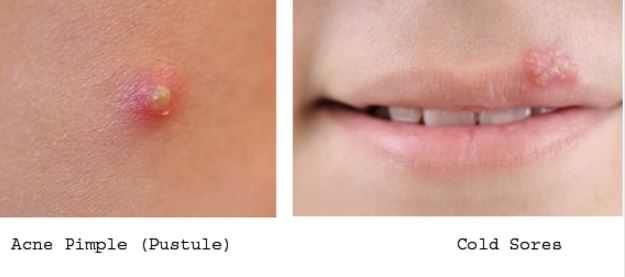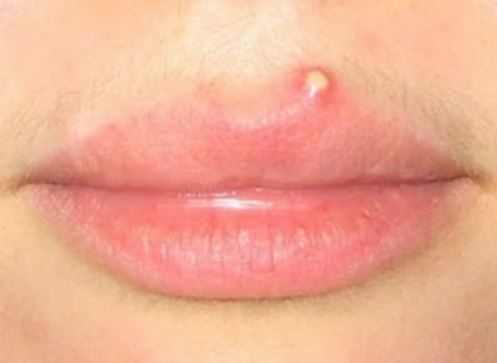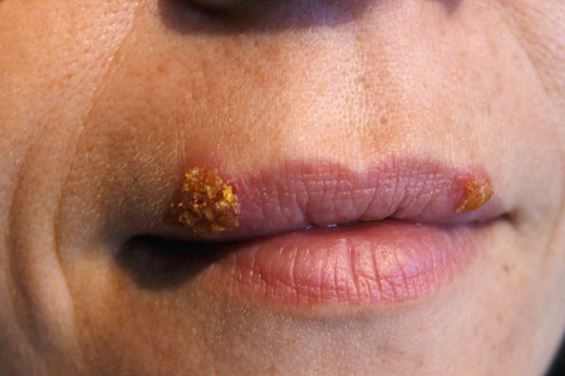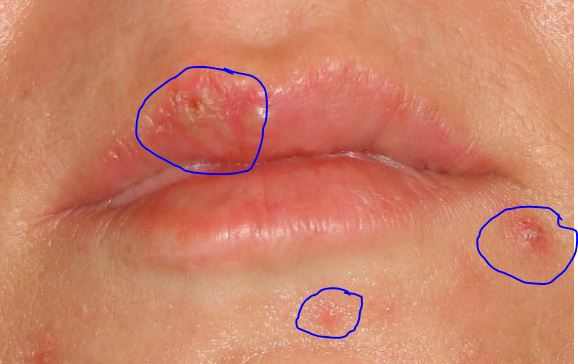Is it a cold sore or pimple on lips? Small cold sores from herpes on the mouth, chin, below nose and on lips can easily be confused with small pimples. Here’s a guide to help distinguish a cold sore vs. pimple or zits, whiteheads etc. See also pictures included.
Cold sores are small blisters that develop on the lips or around the mouth. They are caused by the herpes simplex virus and usually clear up without treatment within 7 to 10 days.

You will not have any symptoms when you first become infected with the herpes simplex virus. An outbreak of cold sores may happen sometime later.
Cold sores often start with a tingling, itching or burning sensation around your mouth. Small fluid-filled sores will then appear, most commonly on the edges of your lower lip.
Cold sore or pimple on lip?

A cold sore and a pimple on the lip may look the same. They both can be uncomfortable. However, there are clear differences between their causes and how they’re treated.
Cold sores, also called fever blisters, are tiny fluid-filled blisters that usually form in a cluster, typically at the edge of your bottom lip.
Before the blisters appear, you may feel tingling, itching, or burning in the area. Eventually, the blisters will pop, form a crust, and go away in about two to four weeks.
A cold sore is usually the result of a viral infection caused by the herpes simplex virus (HSV). There are two strains of this virus, HSV-1 and HSV-2. HSV-1 is the typical cause oral cold sores, and HSV-2 causes sores on the genitals. However, both strains can cause sores on either location if you’re exposed to them.
The herpes virus is very contagious. It spreads easily through skin-to-skin contact. Examples of ways the virus can spread include:
- kissing
- oral sex
- sharing razors
- sharing towels
- sharing eating utensils
If you have the virus, you can spread it even when you’re not having symptoms. The virus is much more contagious during an outbreak or when a cold sore is visible, however.
Not everyone who carries HSV-1 gets cold sores regularly. You may only get one after your initial infection, but the virus still remains inactive and hidden in your body forever. Other people experience regular outbreaks of cold sores that may be triggered by the following:
- Illness or fever
- Sun exposure
- Lack of sleep.
- An immune system deficiency.
A pimple on the other hand, is a tender, small red bump that can have a white tip, a black tip, or no tip at all. Pimples can form on your face, including the edge of your lips, or anywhere on your body.
Pimples are caused by hair follicles getting clogged with oil (sebum) or dead skin cells. Sebum travels through hair follicles to help add moisture to your skin and hair. When extra sebum and dead skin cells build up, they block the pore and bacteria begin to grow. This results in a pimple.
Which Is It?
You should be able to tell the difference by the way each forms and feels. Here are some ways to tell them apart:
- Cold sores tend to show up in one area of the lower lip each time. Sometimes, a cold sore will show up on your upper lip. Pimples can appear anywhere on your lips or face.
- A pimple may be painful to the touch, but a cold sore will also itch, burn, or tingle.
- Pimples have a single whitehead or blackhead. Cold sores are made up of a few tiny blisters clustering together.
Cold Sore vs. Pimple on Lip Line Pictures
What do cold sores look like and what does a pimple look like? While pictures and photos can help a lot in identifying and differentiating, note that cold sores appear as a cluster of bumps. Pimples can appear on their own.
Cold sores erupt within a day of the first sign. Pimples are usually caused by hormonal changes or skin type. Plugged pores usually lead to pimple zits. Here are pictures to help with determine whether you have a cold sore or pimple on lip.

Can a pimple turn into a cold sore?
A pimple may well turn into a cold sore. But this is dependent on whether the zit itself is caused by clogged hair follicles or the herpes simplex virus. If it is caused by the latter, in the beginning stages you might confuse it with a normal zit but as time progresses; it will definitely morph into a cold sore.
How do cold sores start?
Cold sores form either:
- On or at the edge of the lip.
- On the face, near the mouth. This can include the lower portion of the nose.
The appearance of a cold sore (fever blister) will gradually change as it progresses through the five stages of formation outlined below.
The timeline for this transformation (from first sign to complete healing) usually lasts between 8 and 12 days.
1) The Tingle stage (Prodrome stage) – days 1 & 2
In most cases, a person’s first indication that they have a cold sore starting to form is that they notice a new sensation (burning, stinging, itching, soreness, tautness, or swelling) in the area where the lesion will ultimately appear.
What to look out for – The area may become reddened, and slightly raised or elevated (papule formation).
Important information – All of these initial symptoms are signs of inflammation. (Your body’s response to the herpes virus and the tissue damage it’s starting to cause.
2) The Blister stage – days 2 & 3
The first readily visible sign of cold sore formation is the appearance of multiple fluid-filled blisters.
What to look out for – The blisters are usually very tiny (smaller across than the thickness of a dime). And form in a cluster that’s no larger than about the size of a nickel. In some cases, individual blisters may join together to form a single larger one.
Important information – This is the stage where the total number herpes virions (virus particles, HSV) is the greatest. The overall size of the forming lesion generally correlates with the relative number of virions present.
In about 25% of cases, the herpes infection is brought under control (either just by your body’s immune system or with the help of antiviral medication) before blisters can develop. Since no blisters or following ulceration form, these are sometimes referred to as “failed” or “aborted” lesions.
3) The Weeping stage (Ulcer stage) – day 4.
The blisters usually rupture soon after they’ve appeared. As they do, they release a clear fluid teeming with herpes virions. After all have broken, the sore transforms into an ulceration.
What to look out for – Immediately after rupture, the lesion starts off as a shallow red ulcer (a wet, raw looking sore) whose surface then turns grey.
Important information – This phase of fever blister formation can be the most painful stage, and the one during which it’s most contagious.
By this point, the replication rate of the virus has passed its peak. And the inflammation reaction triggered by the presence of the virions and damage to skin cells they have caused is in full swing as it continues to clean up the carnage. It’s this inflammation response (a part of the normal healing process) that’s responsible for redness, swelling and tenderness associated with cold sores as they continue through their stages.
4) The Crusting stage – days 5 through 8.
If the ulcer has formed in a location where it’s not kept wet by moisture from the mouth, it will scab over.
What to look out for – The scabbing looks like a yellow, or dark red to brownish, crust. It often cracks or breaks, which results in bleeding.
During times when a scab has come off, you can see the amount of ulceration that still remains and the pink, newly formed tissue that surrounds it.
Important information– The formation of the scab is often accompanied by an itching or burning sensation. Moisturizing the scab can help to prevent this.
Our favourite moisturizer is the one from CeraVe (Check price on Amazon)
5) The Final Healing stage – days 9 through 12.
As time progresses, so will the sore’s healing.
What to look out for – A series of scabs will usually form on the lesion with each one flaking off before it’s replaced by a new one.
Each new scab will be smaller than the previous one, until finally the lesion resolves fully and in most cases without scarring.
Cold sore vs. Herpes
Herpes is a very common viral infection where there’s much confusion, because not only are there different types of herpes, but oral herpes is also frequently confused with canker sores (also referred to as cold sores), which is an entirely different condition.
First of all, herpes can be broken down into two primary infections:
- Herpes simplex
- Herpes zoster
The herpes simplex infection will affect one of two primary areas and is therefore generally categorized as either:
- Oral herpes
- Genital herpes
Canker/Cold sores
Canker sores, aphthous stomatitis, also known as cold sores, are painful ulcerations that typically occur inside your mouth, inside your cheek, or sometimes even on your tongue.
They are due to an autoimmune problem – typically a reaction to chocolate, citrus, or wheat. It’s important to realize that canker sores will NOT respond to any type of herpes intervention, as it is not a viral infection but an autoimmune condition. If you try to use anti-herpes approaches for canker sores, they simply will not work.
Oral herpes blisters– Herpes lesions are quite different from canker sores, although they too can be very painful. They are typically presented as small, red blisters on your lips.
Symptoms of Cold Sores
Signs and symptoms vary, depending on whether this is your first outbreak or a recurrence. They can last several days, and the blisters can take two to four weeks to heal completely. Recurrences typically appear at the same spot each time and tend to be less severe than the first outbreak.
During first-time outbreaks, some people also experience:
- Fever
- Painful eroded gums
- Sore throat
- Headache
- Muscle aches
- Swollen lymph nodes
Children under 5 years old may have cold sores inside their mouths and the lesions are commonly mistaken for canker sores. Canker sores involve only the mucous membrane and aren’t caused by the herpes simplex virus.
Symptoms of Oral Herpes
Oral herpes is commonly referred to as “cold sores” and “fever blisters.” While symptoms of oral herpes most commonly appear on or around the lips, oral herpes is not always limited to this area.
For some, symptoms may appear between the upper lip, on or inside the nose, or on the chin or cheek. In these instances, herpes is referred to as oral-facial herpes. You have most likely seen someone experiencing an oral herpes outbreak before.
Symptoms of herpes simplex virus typically appear as a blister or as multiple blisters on or around affected areas – usually the mouth, genitals, or rectum. The blisters break, leaving tender sores.
Cold Sore vs. Zit or cold sore or cyst?
Sometimes people tend to confuse acne with cold sores. However, these are two different skin disorders. Even though, both skin conditions share certain common symptoms they have absolutely no similarity when it comes to causes and treatments.
By closely observing the symptoms, you will be able to distinguish between the two conditions. However, when doubt remains, a visit to your dermatologist can lead to a proper diagnosis and a recommendation for appropriate treatment. Cold sores and acne require different treatments, and improper treatment can slow down healing.
Causes of Acne vs. Cold Sores
When oil-producing glands in your skin become blocked, the area can become infected with bacteria. Your body’s immunity sends white blood cells to fight the bacteria, which is what causes pimples.

Cold sores, on the other hand, form on the lips as a result of the herpes simplex virus 1 (HSV-1). Once contracted, the virus stays in your body permanently. However, the sores often only appear as a result of stress or illness.
Location of pimples and cold sores
Cold sores normally form around or right on the lips in the form of clusters whereas acne can mostly be seen in the form of pimples located on the cheeks, forehead, nose, and elsewhere on the face. People may also suffer from back acne as well. Back to cold sore or pimple: Unlike cold sores, however, acne pimples rarely appear on the mouth.
Symptoms
Cold sores are painful and can appear after an illness or stressful situation. The common symptom of cold sore is a tingling sensation in the lips and the area around the lips which continues for a couple of days.
You can go months or years without having cold sores reappear. Cold sores are infectious and can spread from one person to another. Acne pimples can also be painful to the touch but are not connected to any illness.
Cold sores are essentially contagious symptoms and they take at least ten days to heal. While an individual is suffering from cold sore, he or she should avoid sharing food with others.
Acne bumps are significantly larger than the cold sores. Most importantly, acne lesions referred as pimples contain pus. Therefore unlike cold sores, acne is typically marked by formation of pus filled pimples.
However, the term acne is not just restricted to pimples but also refers to other small raised bumps on the skin like whiteheads and blackheads. Acne can last for months or years with frequent breakouts if left untreated.
Every person is susceptible to the herpes virus and thus susceptible to developing cold sores. Acne is most common in adolescents.
Sources on cold sores or pimples
- WebMD: Cold Sores-Symptoms.
- Mayo Clinic: Cold Sores.
- Mercola: Are Cold Sores Really Herpes?
- Acne Treatment Blog: Acne Versus Cold Sores.


